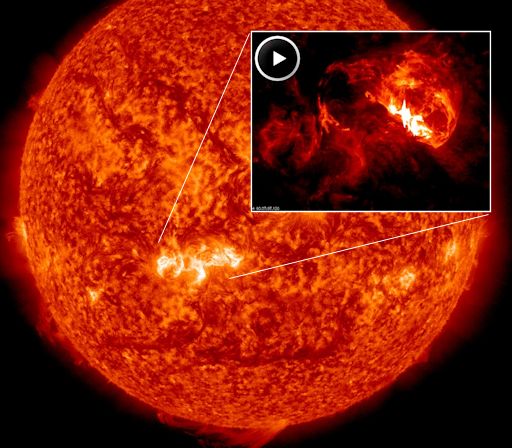CHANCE OF STORMS: Earth's magnetic field is about to receive a glancing blow from three CMEs observed leaving the Sun between Oct. 20th and 22nd. Forecast models suggest that the three clouds merged en route to Earth, and their combined impact could trigger a mild polar geomagnetic storm on Oct. 24-25. High-latitude sky watchers should be alert for auroras. Aurora alerts: text, voice.
SOLAR FLARE! Solar activity is high. On October 24th at 00:30 UT, Earth-facing sunspot AR1877 erupted, producing a powerful M9-class solar flare. NASA's Solar Dynamics Observatory recorded the blast:
Update #1: The eruption hurled a faint CME into space and it appears to be heading toward Earth. The arrival time is not yet known.
Update #2: NASA's Solar Dynamics Observatory has released a full-disk movie of the explosion. Play it.
More flares are in the offing. Two large sunspots, AR1875 and AR1877, have 'beta-gamma-delta' magnetic fields that harbor energy for strong eruptions. NOAA forecasters estimate a 40% chance of M-flares and a 5% chance of X-flares during the next 24 hours. Solar flare alerts: text, voice.

Solar wind
speed: 340.1 km/sec
density: 1.8 protons/cm3
explanation | more data
Updated: Today at 1646 UT
X-ray Solar Flares
6-hr max: M3 1033 UT Oct24
24-hr: M9 0030 UT Oct24
explanation | more data
Updated: Today at: 1600 UT
![]()
Daily Sun: 24 Oct 13
Sunspots AR1875 and AR1877 pose a threat for X-class solar flares. Credit: SDO/HMI
![]()
Sunspot number: 141
What is the sunspot number?
Updated 24 Oct 2013
Spotless Days
Current Stretch: 0 days
2013 total: 0 days (0%)
2012 total: 0 days (0%)
2011 total: 2 days (<1%)
2010 total: 51 days (14%)
2009 total: 260 days (71%)
Since 2004: 821 days
Typical Solar Min: 486 days
Update 24 Oct 2013
The Radio Sun
10.7 cm flux: 153 sfu
explanation | more data
Updated 24 Oct 2013
![]()
Current Auroral Oval:
Switch to: Europe, USA, New Zealand, Antarctica
Credit: NOAA/POES
![]()
Planetary K-index
Now: Kp= 1 quiet
24-hr max: Kp= 1 quiet
explanation | more data
Interplanetary Mag. Field
Btotal: 5.6 nT
Bz: 3.3 nT north
explanation | more data
Updated: Today at 1646 UT
![]()
Coronal Holes: 24 Oct 13
There are no large coronal holes on the Earthside of the sun. Credit: SDO/AIA.





